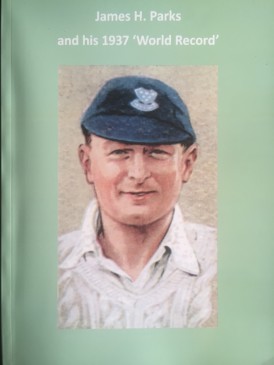James H Parks and his 1937 ‘World Record’
Martin Chandler |Published: 2017
Pages: 88
Author: Epps, Norman
Publisher: Sussex Cricket Museum and Educational Trust
Rating: 3.5 stars

When does a booklet become a book? It is not a question I had ever really thought about until now. But then my copy of this, the latest in a line of impressive publications from the Sussex Cricket Museum and Educational Trust, arrived on my doorstep. It was accompanied by a list of their past output, and that is what raised the issue in my mind. The list comes in three main sections; books, booklets and pamphlets. Tagged on at the end are a couple of further items, limited edition menus to be precise. But the definition of those doesn’t trouble me – menus are categorised as ephemera, of that I have not the slightest doubt.
I also understand why the pamphlets are described as such. They are short runs that, in this instance, will appeal to few other than Sussex supporters and particularly serious sufferers of an addiction to the acquisition of cricketing publications. They are modest affairs dealing with some interesting subjects, but a handful of pages most definitely does not amount to a booklet.
Which brings me back to my opening question. I have previously reviewed two of the Museum’s publications; A Pictorial History of Sussex County Cricket Club and Tony Greig 1946-2012 – A Tribute. The former is a book in any currency, and a particularly splendid one too. The Greig on the other hand is rather different but, at 36 nicely produced and well illustrated pages something I had always categorised as a book.
The museum clearly disagree with me however. As far as they are concerned they have only ever published two books; the club history and that which I am reviewing here. The Greig, and its eight similar brethren that have appeared in recent years are all described as booklets. Having thoroughly examined the evidence it seems to me that there is therefore one factor which marks the distinction between book and booklet. As a paper wrappered issue of modest pagination James H Parks and his 1937 ‘World Record’ in my eyes has rather more in common with the Greig than the club history, so the crucial difference must be that when it is put on the shelves the title and author’s name are printed on the spine. As the old saying goes you learn something new every day.
A further reason to describe this one as a book is the quality of the paper that has been used. James H. Parks and his 1937 ‘World Record’ is not, at £28, in any way inexpensive for an 88 page paperback. It would have been considerably cheaper had art paper not been used throughout, but the number of old monochrome photographs that are used, together with images of contemporary memorabilia, particularly scorecards, fully justify the cost. Poor quality reproduction of those items would have detracted greatly from the enjoyment that is to be had from the book.
As to subject matter the title will give that away to anyone who has ever spent an hour or two going through the records section in Wisden. The record breaker was the first of an English cricketing dynasty, Jim Parks Senior. Jim Junior, wicketkeeper batsman for England and Sussex is the best known of the family. But Jim Senior’s brother, Harry, and his grandson Bobby also enjoyed long First Class careers. As the brief introduction explains the senior Parks had just about as torrid a time as it is possible to have in life before the 1937 season began. If he sought solace by throwing himself into his profession he certainly succeeded. After a sound but essentially unspectacular career until then in 1937 Parks, aged 34, scored 3,003 runs from the top of the order and took 101 wickets with his slow medium inswingers. It is a unique double and will doubtless remain so.
Such was Parks success that he won a call to the England side for the first Test against New Zealand that summer. He opened the batting with another debutant, Len Hutton, 13 years his junior. Parks’ innings of 22 and 7 were rather better than the 0 and 1 the future England captain managed, and he took three decent wickets as well, but when the selectors wanted a change for the second Test it was Parks who gave way. He didn’t play for England again.
Norman Epps could have treated his reader to a rehashing of contemporary press reports and left it at that, although I’m glad he didn’t. What you get is a short biographical introduction at the start of the book, and it finishes with a few statistics and an equally brief epilogue. In between there is a match by match look at the summer, but no commentary as such. Parks’ contribution to the match is set out, and a few quotes from contemporary sources are thrown in to accompany the real highlights which are the many illustrations.
James H Parks and his 1937 ‘World Record’ will not appeal to too many, but anyone interested shouldn’t hang around. There are only a hundred numbered copies, all signed by Jim Junior, available from the museum. As with all such publications anyone struggling to track down a copy should contact us at CricketWeb, and we will happily effect the appropriate introduction.






Leave a comment